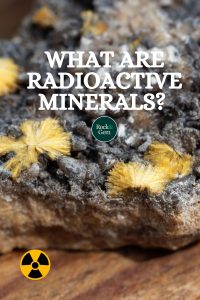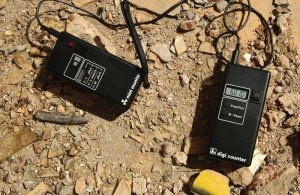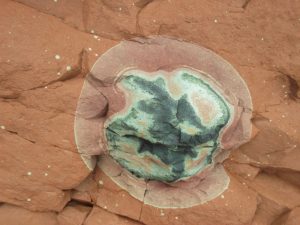
Radioactive minerals like uraninite, carnotite, autunite, and torbernite often have interesting structures and varying degrees of fluorescence. They can be interesting specimens in a rockhound’s rock collection. Fortunately, with the appropriate equipment and safety protocols, it is possible to keep those radioactive rocks while keeping yourself out of harm’s way.
Identifying the Risks of Radioactive Minerals

Understanding which parts of your collection may pose a risk is the first step. You might have just a few individual, radioactive mineral specimens. But some large rocks may also contain an amalgamation of multiple types of potentially radioactive minerals. In addition to these radioactive minerals, there are also daughter products that are created as the result of radioactive decay. Daughter products, such as radium, radon gas and uranium, are themselves radioactive.
According to Alysson Rowan, author of Here Be Dragons or The Care and Feeding of Radioactive Mineral Species, some radioactive minerals may even be hiding in plain sight. “A specimen that doesn’t look very good because it’s not well crystalized — somebody may cut that into a decorative stone and mount it for wearing,” Rowan says. “You can find these things on sale, and there’s no mention of the fact that it is radioactive.”
Based in Holsworthy, England, Rowan is also a former radiation safety worker with extensive training in geology. She continues, “There’s no mention that this is not something that you would want to wear, so, people buy these things and wear them in ignorance.”

Getty Images / Scott Peterson / Contributor
Detection Equipment
Because uranium minerals tend to be very colorful, they’re among the most popular with collectors. “The other thing is that there are a lot of them that are fluorescent,” Rowan says. “With uranium minerals, you tend to get greens and yellows, but there are minerals that glow blue, and red, and I think there’s even one that’s now known to fluoresce purple.”
Incidentally, to test the radioactivity of your stash, you’ll want to purchase a handheld radiation detector. “If they’re going somewhere to collect uranium minerals or they expect to find uranium minerals, a handheld ‘Geiger counter’ is a must-have,” Rowan suggests. “Of course, they’re not all Geiger counters now. . . . A lot of them are scintillators which are a lot more sensitive and a lot more durable. They generally show how much radiation they’re detecting either on a meter or on an alphanumeric display.”
You can also find used Geiger counters for sale online. “A lot of people buy them second-hand on eBay,” she says. “The American Civil Defense monitors are very, very popular because there’s a lot of them about.”
Saléeite and autunite are two colorful — and radioactive — minerals. “In bright sunlight, you can see the fluorescence,” Rowan notes. Both are in the bright yellow-green range.
Just don’t get too attached to that autunite, as it will literally disintegrate. “Autunite is what’s known as a metamict,” Rowan explains. “It decays radioactively, and the radiation damages the crystal. Inside a few years, it’s just a pile of dust. . . . And, so, autunite will actually spread all over the place.”

Photo courtesy of Alysson Rowan.
Radiation Effects
Containing that radioactive spread is paramount because the negative effects of radiation on the body are cumulative. In other words? The radiation you absorb builds up over time. You can inadvertently expose yourself to radiation internally by absorbing contaminants through your skin. You can also inhale or ingest radioactive contaminants.
The acute effects of radiation exposure can range from erythema — akin to a deep tissue sunburn — to renal failure. “The uranyl minerals—that is uranium oxide as a radical—are toxic to your kidneys,” Rowan says. “So, that is what you’ve got when you pick up most fluorescent minerals. It’s uranyl phosphates, uranyl nitrates—they are highly toxic.”
Over the long term, exposure to some radioactive compounds can even result in bone cancer and leukemia. In her book, Rowan writes, “Inhaled uranous and thorium compounds, and to a lesser extent the uranyl compounds will result in both toxic and radiation damage to the lung. Long-term effects will include bronchitic and emphysema-like symptoms as well as a range of pulmonary and pleural cancers.”

Smoke Alarm
Keeping cigarettes, incense, and other smoky stuff away from radioactive specimens is especially important.
For safety’s sake, you should never eat or drink while handling radioactive minerals. Applying a quick smidge of lip balm’s another no-no. And smoking is right out, too.
“The thing about smoking is one thing that you do is that you handle the rock and you put your cigarette to your mouth and you’ve immediately got rock dust on your lips,” says Alysson Rowan, the author of Here Be Dragons or The Care and Feeding of Radioactive Mineral Species.
What’s more, let’s say some of your specimens contain uranium. As uranium goes through its multiple stages of decay, it eventually releases radioactive radon daughter products and radon gas. “The airborne activity from radon daughters and radon gas itself will attach themselves to smoke,” Rowan continues. “So, when you re-inhale smoke, you’re inhaling the radioactive contaminants in the atmosphere.”
In her work, Rowan writes, “It has been noted that the presence of blue smoke from cigarettes (the plume that rises from the burning tobacco) collects the radioactive radon daughter products more surely than any other means of concentration. This means that the spent smoke you breathe in a high radon concentration area is bringing those radioactive materials into your lungs in a form which tends to remain inside your body.” Such radiation exposure in the human body is cumulative. Rather than dissipate, the radiation exposure adds up. “The consensus of scientific opinion is that a given dose from radon is possibly 10 or 15 times as dangerous to a smoker as to a nonsmoker,” Rowan notes. To mitigate this risk, never smoke in areas where you keep radioactive specimens.
Minimizing Exposure
Although different minerals pose differing degrees of risk, if you are pregnant, you should avoid contact with radioactive minerals altogether. As for young children? “Before puberty, we are a lot more susceptible to radiation damage because of the rapid cell division,” Rowan says. “Children should not be around. . . radioactive minerals more than absolutely necessary for their study.”
There are several precautions you can take to minimize your overall radiation exposure and still appreciate the radioactive specimens in your collection. Besides the degree to which a mineral is radioactive, the amount of the mineral in question matters as well as the cumulative amount of time that you spend in direct contact with it.
“If you sit with a pound of uraninite using it as a paperweight on your desk, that is going to give you a problem eventually,” Rowan maintains. “If, on the other hand, you have that pound of uraninite and it’s in a lead-acrylic case, that reduces the dose rate and, therefore, it’s not quite the same problem.”

Photo courtesy of Alysson Rowan.
Display Do’s and Don’ts
“You also have to take into account how far you are from that specimen,” Rowan adds.
When you increase the distance between yourself and the specimen, you decrease your potential radiation dose. Adding shielding materials like lead, wood or glass can further reduce your radiation exposure.
“For the most part, you put [your collection] on display in a cabinet,” she says. “The idea is that you’re keeping dust off of your specimens, but you’re keeping dust from the specimens fixed.”
Regarding those uranium-rich minerals, keep in mind that uranium decays into radium which, in turn, will decay into radon gas. Because this heavy, radioactive gas can easily migrate, you should air out your uranium mineral display cases periodically. “I’ve done this with my own cabinet,” Rowan says. “You open the cabinet and stick your [radiation] meter in and the radiation count goes up. And, over about half an hour, the count rate goes right down, because the radon daughters in there only have a short half-life.”
Still, she cautions, “If you’re a serious uranium collector, then it’s probably a good idea to have vented cabinets—venting to the outside world.”
Also, never store or display uranium minerals in a basement. “Radon gas is an awful lot denser than air,” Rowan explains. “It’s a big atom and it will hang around for a couple of weeks.”
Handling How-To’s
If you do need to handle a radioactive mineral specimen, don’t dally. “If you’re working with it for too long, that’s all additional exposure,” Rowan says. “So, the amount of time that you’re in contact with the rock, you need to minimize it. And you need to make sure that you don’t spread contamination everywhere.”
To that end, she suggests wearing protective clothing and disposable gloves and protecting your work surface with a disposable covering. Washing carefully with soap and water is also key. “If you handle a radioactive rock, you’ve got radioactive rock dust on your fingers and you’ve got to wash it off,” Rowan says.
Finally, to prevent ingestion or inhalation of radioactive contaminants, never eat, drink or smoke when working with radioactive minerals, and, Rowan concludes, “Don’t be paranoid, but do take care.”
This story about radioactive minerals appeared in Rock & Gem magazine. Click here to subscribe. Story by Susan M. Brackney.













